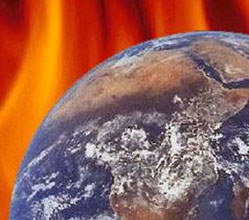Glacial ice sheets existed on Earth even during ancient global warming
Washington, Jan 11:  A new research has indicated that glacial ice had existed on Earth even during intense period of global warming 91 million years ago.
A new research has indicated that glacial ice had existed on Earth even during intense period of global warming 91 million years ago.
Carried out by a team of researchers at Scripps Institution of Oceanography at UC San Diego, US, the new research challenges the generally accepted belief that substantial ice sheets could not have existed on Earth during past super-warm climate events.
For the study, the team examined geochemical and sea level data retrieved from marine microfossils deposited on the ocean floor 91 million years ago during the Cretaceous Thermal Maximum period.
This period was an extreme warming event in Earth’s history that raised tropical ocean temperatures to 35-37°C, about 10°C warmer than today, thus creating an intense greenhouse climate.
Using two independent isotopic techniques, researchers at Scripps Oceanography studied the microfossils to gather geochemical data on the growth and eventual melting of large Cretaceous ice sheets.
The researchers compared stable isotopes of oxygen molecules (d18O) in bottom-dwelling and near-surface marine microfossils, known as foraminifera, to show that changes in ocean chemistry were consistent with the growth of an ice sheet.
These independent methods provided Andre Bornemann, lead author of the study, with strong evidence to conclude that an ice sheet about 50-60 percent the size of the modern Antarctic ice cap existed for about 200,000 years.
“Until now it was generally accepted that there were no large glaciers on the poles prior to the development of the Antarctic ice sheet about 33 million years ago,” said Richard Norris, professor of paleobiology at Scripps Oceanography and co-author of the study.
“This study demonstrates that even the super-warm climates of the Cretaceous Thermal Maximum were not warm enough to prevent ice growth,” he added.
But, researchers are still unclear as to how ice growth could have started in the Cretaceous.
According to the researchers, climate cycles may have favored ice growth during a few times in the Cretaceous when natural climate variations produced unusually cool summers. Likewise, high mountains under the modern Antarctic ice cap could have been potential sites for growth of large ice masses during the Cretaceous. (ANI)